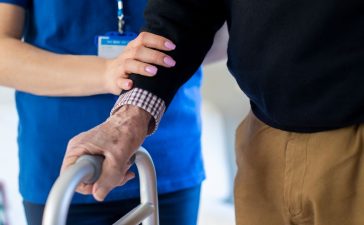Last winter, my 53-year-old sister told me she was tired of her profession and wanted to become a therapist. Nothing noteworthy there: 76% of psychotherapists are women and it’s been that way for decades. I surprised my sister by confessing that, after 25 years as a journalist, I, too, wanted to become a therapist – and was already in graduate school making it happen.
My sister soon texted that she’d told her husband, Mario, and it turned out that he, too, was thinking of becoming a therapist.
Mario is a wonderful man: 52 years old, kind and funny, played football at Colorado State, great father. Mario spent the last 15 years working for major media companies and while I knew he’d been laid off, he’d be a shoo-in for another high-level job. So when he called, I said I was surprised.
“I can’t see growing old in corporate America,” Mario said. “I gotta do something more meaningful. Tell me the deal with graduate school. How’s it work?”
I told Mario the master’s degree would take two years and require 300 hours of unpaid work in a non-profit mental health clinic. Then I could start seeing clients and getting paid but only under the supervision of a licensed therapist. I’d have to work 3,000 hours that way, making anywhere from zero to $80,000 a year, before I could get licensed myself. After that, I could charge maybe $150 an hour.
Two weeks later, Mario enrolled in my graduate program.

A few weeks later, my wife, who is a journalist, was on the phone with one of her editors. She turned to me and said, “Hey, sweetie, would you mind talking to my editor’s husband for a second? She told him you’re becoming a therapist and he’s apparently curious.”
My wife handed me the phone and I told another fiftysomething male creative – he’s in publishing – the details I’d given Mario plus new ones. These included the American Psychological Association (APA) reporting a shortage of male psychologists – especially Asian, African American and Hispanic male psychologists, who collectively represent less than 3% of the current psychology workforce. Also, advanced age was thought to be a bonus. Life experience, and all that.
After I hung up, my wife showed me a text: “OMG,” it read. “I think your husband just talked my husband into becoming a therapist.”
About a month later, at a funeral in my home town, I saw a high-school buddy named Jasper who moved to Prague in his 20s and opened a bookstore there, then came home, got an MBA and worked in tech companies. Recently, Jasper said, he’d gotten burned out and left corporate life to become, yes, a therapist. Mario then heard that yet another guy we both knew, Eitan, a design-build contractor, had also just decided to become a therapist – after working on the home of yet another man our age who was himself becoming a therapist.
This unexpected sequence of events told me that something might be changing in men’s attitudes toward the profession of psychotherapy.
Five anecdotes, of course, do not add up to data. It is also true that psychology used to be overwhelmingly male (see: Freud). Back in the 1950s, 75% of all advanced degrees in the field went to men. By 1976, though, a big influx of women into psychology – with no corresponding increase of men – put the profession at gender parity.
Even more striking is what has happened in the half-century since. As the US population has grown by more than 100 million people – and the number of women getting advanced psychology degrees quadrupled to more than 30,000 – the number of men getting such degrees has remained dead flat at about 7,500 a year for 45 years.

Put another way, even if Mario, Eitan, Jasper, and myself are bellwethers of a broader change in the culture – and I believe we are – something has been stopping men from becoming therapists for a long time.
James McCollum, a San Francisco-based psychologist specializing in men’s issues, speculates that one factor was the surge of women entering the American workforce in the 1970s and 80s. “Certain jobs rewarded traditionally female traits like caring and empathy,” McCollum says. “So therapy was a natural fit for women.” As early as the 90s, McCollum says, the conventional American image of a psychotherapist – and of the profession as a whole – had probably become female.
According to Ryon McDermott, former president of the Society for the Psychological Study of Men and Masculinities, also known as Division 51 of the American Psychology Association, this influx of women into therapy may have had the peculiar side-effect of discouraging certain men from joining the profession – even men who might have enjoyed and benefited from the career.
“Men in general stay away from feminine careers even if they pay well,” says McDermott, with a rueful smile. “A really good example is nursing. If you want good employment and great opportunities, nursing is a great way to go and men avoid that like the plague.”
Another cultural factor limiting the number of male therapists, McDermott says, is the stigma that many men – and Americans more generally – feel around seeking mental-health treatment. This means that fewer men overall have contact with the profession, leaving an even larger number unlikely to join it.

Curt Widhalm, a clinical psychologist in Los Angeles and co-host of the podcast Therapy Reimagined, cites still other factors that might keep men from becoming therapists, like the many years of low-paid work required to get licensed. Widhalm also mentions a somewhat surprising concern that I heard echoed by numerous other male clinicians: namely, that male graduate students in psychology find themselves in such a small minority, in classroom conversations dominated by feminist discourse, that they feel unwelcome – and therefore more likely to drop out.
Kiernan Warble, a San Francisco-based psychotherapist, points out how churlish this can sound. Women have forever been in the professional minority in almost every line of work imaginable, she says, and men enjoy great privilege in most of public life, but now we’re supposed to feel sorry for a few men who wish there were more dudes in their graduate programs? Warble adds, though, that mental health is a truly peculiar case insofar as the field really does need more men – men of color in particular – and also, given the point of the whole exercise, a deeper understanding of what it feels like to be a man.
My friend Jasper’s experience, as one of only three cisgender men in a graduate-school cohort of 20 students, reflects this – with an upside. “It’s been eye-opening and humbling to be part of a minority,” he says, “although it’s also made me think about how easily I move through the world – how I can walk down the street unmolested.”
Jett Stone, a psychologist in New York and Connecticut who specializes in treating men, recalls his own training in similar terms. “The word is lonely,” he said. “There weren’t a lot of men and when I did come across them, we were like, ‘Did you watch the Rangers game last night?’”
Stone says he went into psychology because men were “a mystery” to him. “I wanted to figure out who these hard-ass hockey coaches I’d had were and figure my father out.”

But he found that while feminism had “weaved its way nicely into psychotherapy”, resulting in complex discussions of women’s gender and sexuality, conversations about boys, men and masculinity were far less common. “If anything, there was a reluctance to look deeply,” he says of the pedagogical attitude toward boys and men during his years of graduate study – born, perhaps, of female students’ less intimate understanding of these subjects or the positive momentum towards women’s issues in a profession where women were finally ascendant, after an eternity on the margins.
Either way, says Stone, when discussion did turn toward the inner lives of men, “it was all about emotional restriction and gender norms of toughness and aggression and self-reliance or sexual objectification, homophobia. It just didn’t capture the nuance – the experience of being a man that I knew and other guys knew.”
Stone points out that the stakes are high. American men are four times as likely as women to die by suicide. (Women attempt suicide at greater rates, but suicide attempts by men are more likely to involve firearms, and therefore to end in death.) The percentage of American men seeking therapy has also risen 30% in recent years.
In McDermott’s view, the paucity of male therapists “matters in the same way that race representation matters. Men are 49% of the population but they constitute maybe 5 or 10% of the psychology graduate students right now.”
Of course, not all male clients need or prefer male therapists: in 2021, an Australian research team led by Zac Seidler at the University of Melbourne found that only 40% of men said they cared about a therapist’s gender and only half of those preferred men. McDermott, though, doubts that such a study would produce the same finding in the US. The Australian government, he says, has done better public-health messaging around men’s mental health.
Plus, McDermott adds, during his own training in mental health clinics, “I got all the men automatically. They wanted to work with another man. Same way men prefer to talk with a male doctor about certain things like erectile dysfunction.”
Daniel Ellenberg, another former president of the APA’s Division 51, agrees. “Guys sometimes need to talk to a guy,” he says. “They don’t want to talk to a woman about their pornography use. There are some areas that are really uncomfortable and shame triggering – like the fact that guys objectify women is not something that women like to hear about, and men know that.”
These are serious matters, according to Stone, “because 50% of men who die by suicide have been in contact with mental health professionals” – clearly, something’s not working – “to the point that some therapists are reluctant to treat men, especially men with suicidality. Men attend fewer therapy sessions on average than women and drop out earlier.”
“So the question becomes, how do you engage men to do therapy?” Stone says. Engagement matters, he points out, because the fundamental ingredient in any successful therapy is therapeutic alliance – a feeling of mutual trust and comfort between therapist and client. “If you don’t have an alliance,” Stone says, “you don’t have a working therapy. So how do you build an alliance with men?”
Stone sees a need for more therapists with what he calls an “on-the-ground, nitty-gritty experience of what it’s like to grow up to be a boy, of how to grow up into a man – of when traditional masculinity works for you and when it doesn’t”. That lived experience, Stone says, comes out in the way male clinicians speak to male clients – “a bigger picture understanding”, as he describes it, “that masculinity isn’t just a toxic list of traits that we need to change”.

At the very least, Stone says, there is a need for training aimed at helping therapists of all genders build therapeutic alliance with men.
“There’s a disconnect between the culture wars about masculinity and the experience of actually doing emotional engagement with men on a daily basis,” he says, adding that his male clients sometimes describe their work together as a form of mental cross training.
They want to learn to connect at a deeper level with others, name their emotions and learn “this cultural language that girls are much more likely to be brought up understanding”, Stone says. They want to retain their masculinity and sense of self, in other words, but also “articulate shame with other guys and cry and work through some of these things that we wouldn’t dare in the hockey locker room”.
That resonates with me. Back in my 20s, I saw an excellent female therapist for relationship issues but was uncomfortable with the fact that I wept in every session – a me problem, needless to say – so I quit.
Years later, though, when fatherhood got me seeing a psychoanalyst – who happened to be male – something clicked. I don’t know if my analyst’s gender was a factor, but over the next 20 years, he helped me avoid suicide, divorce, traumatizing my children more than necessary (although they’ll be the final judges of that), and, after I lost a job, choosing to live alone in a van near a beach where I could surf. From that experience, I learned that psychotherapy could be a private space in which men hashed out life’s great questions.
That all encouraged me to become a therapist myself, but so did money. Therapy does not pay well, especially for beginners, but it beats freelance journalism. Plus, as any ageing male creative can testify, the existence of a meaningful profession in which older men are in short supply and capable of working into their 70s and beyond is, to put it mildly, mind-blowing.
The APA projects an enormous mismatch, in coming years, between therapist supply and demand, while the US Bureau of Labor Statistics expects the overall number of clinical and counseling psychology jobs to rise much faster than total employment in the next 10 years.
Mario’s reasons for becoming a therapist are different from mine. A painful childhood and the untimely death of his father, during Mario’s teenage years, gave him a lifelong interest in psychology and Buddhism. “When I got laid off,” Mario says, “becoming a therapist looked like a great way to grow old with purpose.”
Jasper, too: his parents’ early divorce set him on a wandering path after college into what he calls the male, American capitalist world of business. “Like, ‘You should go out there and dominate and make a bunch of money and fuck other people,’” Jasper says. Becoming a therapist was about “making a heart-based decision and following my true self. I actually have a lot of energy and compassion for helping people,” Jasper says. “And that is a big deal for one’s life – to recognize what your values are and be more aligned with them.”
Eitan, for his part, worked as a fine-art sculptor before starting a family and going into construction. Along the way, Eitan says, he struggled with mental health: “I tried every antidepressant known to man,” he told me. “My family came from Israel with $15 and didn’t speak the language, put their nose to the grindstone and worked like animals, and that’s the way I was raised. I’ve been doing that for years but now I’m feeling like, ‘OK, this is not serving me any more.’ So therapy is about turning toward something that’s my own.”
McCollum says there’s an old joke: “People who study economics want to make a lot of money, and people who study psychology want to figure out what the hell happened to me.” He thinks ideas about masculinity are changing. “No one’s going to be John Wayne or Gary Cooper any more,” he says. “Men have learned to be more psychologically minded. Part of it is also, ‘How do you give back? How do you live a life of meaning?’”
As for what might be nudging men like my friends and me in this direction, says Stone, “therapy has been slowly destigmatized in our culture. More people talking about it – ‘Oh, I see my friends doing it. I’m going to do it as well.’”
But there’s also the masculine appeal of helping out during a crisis, he says. Think of firemen, running into burning buildings. “Maybe it’s not articulated consciously, but we’re rushing to a place that we’re needed. Like, ‘We have a purpose here. Let’s go!’”











